The second bill included in the Safer Beauty Bill Package is H.R. 4433 Cosmetic Supply Chain Transparency Act, introduced by Rep. Schakowsky.
This bill has several components. On its face, it looks like it will provide small businesses and handcrafters with access to cosmetic ingredient safety information by requiring manufacturers and suppliers to make that data available. That said, if passed, it will also impose significant record-keeping requirements on suppliers, manufacturers, and brand owners (that’s the person/business identified on the label). It also carries the potential for hefty civil penalties for non-compliance.
Cosmetic and Ingredient Safety information
One of the more positive aspects of the bill is that, on request by the brand owner, the supplier of a cosmetic or ingredient must provide:
(1) The following information:
- Functions and uses.
- The human health and environmental hazards.
- The physical and chemical properties.
- The Chemical Abstracts Services Registry number of any such ingredient.
- Environmental exposure and fate information (results of exposure).
- Heavy metal testing results.
- Safety data sheets.
- Manufacturing flow charts.
- Composition statement.
- Fragrance allergen statement.
- International Fragrance Association (IFRA) standards conformity certificate.
- Any other information used to substantiate the safety of such ingredient.
(2) A full and complete listing of ingredients in fragrance or flavor formulations, preservative systems, or other ingredient formulations, including the presence of any allergens.
(3) A full and complete listing of ingredients in a finished cosmetic presented in descending order of predominance by weight, except that ingredients present in amounts of 1 percent or less by weight can be placed in any order at the end of the ingredient statement.
(4) A certificate of analysis for the ingredient. (There will be additional requirements for the certificate of analysis once nonfunctional constituents are identified, see below.)
This is good for us. The brand owner is the one responsible for safety substantiation of the cosmetic product and this requires the supplier to provide the necessary information. When the supplier is a contract manufacturer, they’d need to provide the information on the cosmetic product; when the supplier is an ingredient vendor, they would need to provide information on the ingredient.
The supplier will be required to provide the information within 90 days of being asked. Violation can be liable for a civil penalty of up to $10,000 for each DAY the violation exists. (WOW!) (There’s no information about how penalties would be invoked.)
One possible downside is that small suppliers are not exempted. That may be a significant burden on smaller suppliers. Hopefully it wouldn’t be enough to drive them out of business.
Nonfunctional Constituents
The bill also requires that the FDA create and maintain a list of “nonfunctional constituents” that are known or reasonably expected to be present in cosmetics or ingredients and which are considered harmful to human health or the environment.
Harmful to human health of the environment is defined as:
A) Being:
- a reproductive or developmental toxicant;
- persistent, bioaccumulative, and toxic;
- an allergen; or
- an endocrine disruptor, carcinogen, or mutagen;
AND
B) Is present on the most recent version in effect of any of the following lists:
- Chapter 6.6 of the California Safe Drinking Water and Toxic Enforcement Act of 1986 (sections 25249.5 through 25249.14 of the California Health and Safety Code), List of Reproductive and Developmental Toxicants and Carcinogens (also known as the Prop 65 list)
- Chemicals classified as ‘Persistent, Bioaccumulative and Toxic’ by the Toxics Release Inventory published by the Environmental Protection Agency pursuant to section 313 of the Emergency Planning and Community Right-to-Know Act of 1986.
- European Union Regulation 1223/2009/EC on Cosmetic Products, as amended by Regulation (EU) 2020/1683, Annex II–Prohibited Substances.
- Annex III of European Union Cosmetics Regulation No. 1223/2009, as required to be disclosed pursuant to European Union Detergents Regulation No. 21648/2004.
- Chemicals included in the European Union Candidate List of Substances of Very High Concern in accordance with Article 59 of the REACH Regulation (EC) No. 1907/2006 on the basis of fulfilling the criteria defined in Article 57(f) for endocrine-disrupting properties.
- Substances classified as carcinogens, mutagens, or reproductive toxicants in Appendices 1–6 of Annex XVII to Regulation (EC) No. 1907/2006 of the European Union’s Registration, Evaluation, Authorisation, and Restriction of Chemicals (REACH) law, as revised by the Commission Regulation (EU) 2020/2096 of December 15, 2020.
- Group 1, 2A, or 2B carcinogens identified by the International Agency for Research on Cancer of the World Health Organization.
- Any other list the Secretary determines appropriate for purposes of this subchapter.
One important thing to note about the definition (above) is that it includes the MOST RECENT VERSION of each of those lists. For example, if California updates the Prop 65 list or the EU updates the prohibited ingredients annex of their Cosmetic Regulations, that would AUTOMATICALLY update the US list of “harmful nonfunctional constituents.”
The idea is that these “harmful nonfunctional constituents” may not be declared in the ingredient declaration on a cosmetic because the are classed as “incidental ingredients” or weren’t intentionally added to the cosmetic for some reason.
There’s a whole process in the bill for setting up an advisory committee to advise on creating the list and analytical testing for the nonfunctional constituents. The list is supposed proposed and finalized within 18 months of the bill’s enactment (if it passes and is signed into law).
Concurrent with publishing the list, the FDA is supposed to issue guidance for industry on best practices related to analytical testing for harmful nonfunctional constituents and detection limits.
Certificate of Analysis
Suppliers will be responsible for testing the material they sell to determine the level(s) of any nonfunctional ingredient(s). Then, within a year after the list and the testing criteria exist, suppliers must provide, PRIOR TO THE SALE of any cosmetic or ingredient, a certificate of analysis that includes:
- The levels of each such nonfunctional constituent present;
- Any analytical test used;
- The detection limits of any analytical test used to detect each such nonfunctional constituent; and
- Heavy metal testing results.
Again, this requirement will be a significant burden to small vendors unless there are provisions requiring the manufacturer of the cosmetic ingredient to perform the required tests.
Failure to comply makes the supplier liable for a civil penalty up to $10,000 per day. (Again, WOW!)
Adulterated or Misbranded Cosmetics
Under this bill, keeping records of the supply chain for any cosmetic and its ingredients becomes the responsibility of the brand owner. That is, the business that puts the product on the market (and is on the label as the responsible person/business).
In the case that a cosmetic is found to be, or suspected of being, adulterated or misbranded the FDA would have the authority to request from the brand owner (and the brand owner must provide):
- The name and place of business of the manufacturer of the cosmetic and any supplier of an ingredient or raw material used in the manufacture of the cosmetic
- The name and place of business of any entity (including any retailer) to which the brand owner provided the cosmetic.
In order to comply with this part of the bill, even small businesses and handcrafters would have to keep accurate records of the supplier of every ingredient or raw material used in a cosmetic product. In a perfect world, that information would be tracked when you receive ingredients and your batch records would track when ingredients (with supplier data) are used, all as part of your good manufacturing practices. Even so, it’s still a LOT of work,
In addition, you’d have to keep a record of the name and place of business to which you sold or provided each cosmetic product.
Granted, it’s not likely that the FDA would come knocking on your door about an adulterated or misbranded product and ask for the information … but if they DID, you’d need to have it handy.
Again, a possibility of civil penalties of up to $10,000 per day for failure to comply – so it’s not something to take lightly.
Why Does It Matter
On the surface, this bill looks like it could be helpful to small businesses because it requires suppliers to provide safety information. That would be nice, and make it much easier to get and keep safety substantiation for your cosmetic products.
On the other hand, it would add significant record-keeping requirements for every small business making and/or selling cosmetic products.
Finally, it would add heavy burdens on suppliers, especially those specializing in selling smaller quantities of items to small businesses and handcrafters. Unless there are provisions for placing the responsibility for TESTING on manufacturers (not necessarily the low-level suppliers in the supply chain), it could be devastating.
And then, of course, there are the potential civil penalties!
Good news, though, is that there is a long way to go before this bill becomes even a problem to worry about. At present, it has been referred to the House Committee on Energy and Commerce.


Leave a Reply